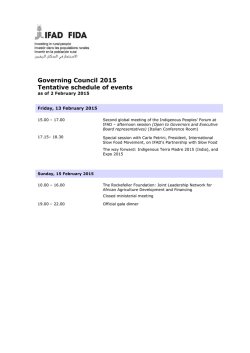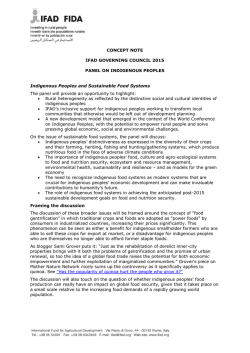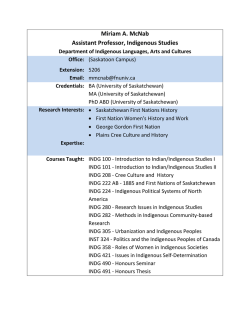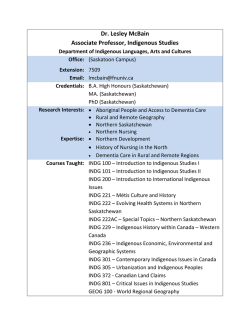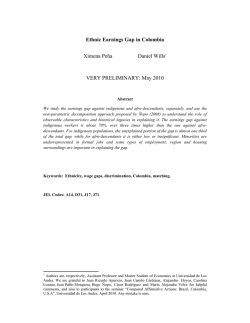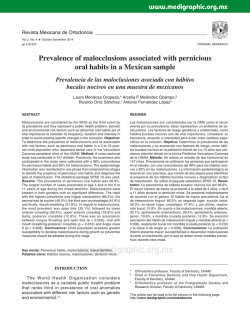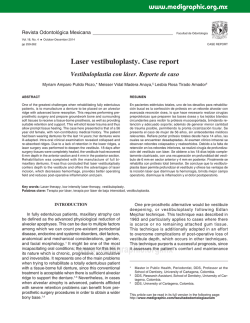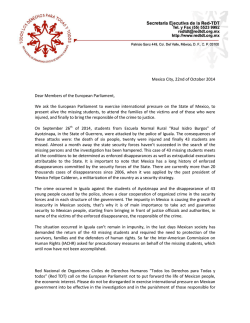
maximum bite force in elderly indigenous and non - SciELO
ACTA-3-2014:3-2011 06/12/2014 04:32 p.m. Página 115 115 MAXIMUM BITE FORCE IN ELDERLY INDIGENOUS AND NON-INDIGENOUS DENTURE WEARERS Eduardo Borie1,2, Iara A. Orsi2, Ramón Fuentes1, Víctor Beltrán1, Pablo Navarro3, Felipe Pareja5, Lariça B. Raimundo4 1 Physiology and Oral Microsurgery Research Center (CIMOFIR), Dental School, Universidad de La Frontera, Temuco, Chile. 2 Department of Dental Materials and Prosthodontics, Ribeirão Preto Dental School, University of São Paulo, Brazil. 3 Mathematics and Statistics Department, University de La Frontera, Temuco, Chile. 4 Private practice, Santos, SP, Brazil. 5 EDF Centro de Salud Familiar Puqueldón, Chiloé, Chile. ABSTRACT The aim of this study was to compare the measures of maximum bite force (MBF) in elderly edentulous indigenous (Mapuche) and non-indigenous individuals with new complete dentures at two different measuring times. A sample of 100 elderly subjects was divided into two groups: 50 indigenous and 50 non-indigenous, each including 25 females and 25 males. All individuals were totally edentulous, with new maxillary and mandibular removable complete dentures. Measurements were taken at the time of new prosthesis placement and after 1 month of use. Subjects were asked to perform with maximum effort three bites per side at maximum intercuspidation, with a rest time of 2 minutes in between. Statistics were analyzed with Student´s t-test. The MBF values were significantly higher in indigenous than non-indigenous subjects. Force after 1 month of wearing the new prosthesis was significantly higher than at the time of new prosthesis placement. No significant difference was found between sides. Elderly indigenous complete denture wearers had the greatest MBF values. Denture wearers were observed to undergo an adaptation process to the new prosthesis, with MBF increasing considerably after one month of use. Key words: Bite Force; Aged; Dentures; Health Services, Indigenous. FUERZA MÁXIMA MASTICATORIA EN PACIENTES ADULTOS MAYORES PORTADORES DE PRÓTESIS TOTALES INDÍGENAS Y NO INDÍGENAS RESUMEN El objetivo de este estudio fue comparar las medidas de fuerza máxima de mordida (MBF) en pacientes desdentados adultos mayores indígenas (Mapuches) y no indígenas, en el momento de recibir sus prótesis totales y un mes posterior a la inserción. Una muestra de 100 sujetos adultos mayores fue dividida en dos grupos: 50 indígenas y 50 no indígenas, cada uno de ellos con 25 pacientes de sexo femenino y 25 masculino. Todos los individuos estudiados eran completamente edéntulos, quienes recibieron prótesis removibles totales nuevas tanto superior como inferior. Las medidas fueron realizadas en el momento de la inserción de ambas prótesis y posterior a un mes de uso. Se les solicitó a los sujetos que realizaran un esfuerzo máximo con tres mordidas por lado en máxima intercuspidación, con un tiempo de descanso de 2 minutos entre cada medición. El análisis estadístico fue realizado por medio del test t-Student´s. Los valores de fuerza máxima observados en los sujetos indígenas fueron significativamente mayores que en los individuos no indígenas. Además, los valores de fuerza posterior al mes de uso de la prótesis nueva fueron significativamente mas altos que los obtenidos al momento de la inserción de la prótesis. Por otro lado, no se identificaron diferencias significativas en los valores entre los lados izquierdo y derecho. Así, los pacientes indígenas mostraron valores mayores de fuerza masticatoria máxima. También, se pudo observar que los pacientes sufrieron un proceso de adaptación a las prótesis nuevas, en los cuales la fuerza máxima masticatoria posterior a un mes aumentó considerablemente. INTRODUCTION Considering the constant increase in elderly people in the world population, it has become important to evaluate muscle changes associated with age1,2. When people age, their muscles undergo functional changes, mainly through atrophy and tooth loss1,3. Maximum bite force (MBF) is directly related to chewing, and is determined in elderly subjects by the loss of muscle mass expressed as a reduction in the number and size of muscle fibers during the natural aging process4-7. In addition to influencing the chewing function, MBF also influences diet choice, which Vol. 27 Nº 3 / 2014 / 115-119 Palabras clave: Fuerza masticatoria; Anciano; Prótesis; Servicio de salud, Indígenas. ISSN 1852-4834 Acta Odontol. Latinoam. 2014 ACTA-3-2014:3-2011 06/12/2014 04:32 p.m. Página 116 116 Eduardo Borie, et al. has an important role in the maintenance of musculoskeletal function7-9. This is because elderly people with fewer or no molars avoid fibrous foods, crisp foods, and dry solids, showing reduced food intake ability and leaving out many sources of proteins, fibers, minerals and vitamins10. Even more serious is the fact that urban human diet is usually mainly based on soft foods which are rich in carbohydrates and poor in proteins and fibers11. In contrast, some indigenous groups eat roots and dried fruits, and food that is less cooked and rudimentarily roasted11. The Mapuche race is the most predominant indigenous group in Chile and one of the largest groups in the continent12. In Chile, 19.7% of the population belongs to the Mapuche ethnic group, though a lower percentage is limited to living in rural areas13. The general physiological changes that members of this group undergo in old age do not differ from those of non-indigenous people13. The Mapuche staple diet is based on fruits and forest species, mainly nuts, grains, fruits, and dried meats, with less cooking preparation and harder consistency12,14, possibly affecting the force exerted by the masticatory muscles when chewing, although chewing and its components have not been studied in Mapuches. The aim of this study was to compare MBF in elderly edentulous indigenous and non-indigenous individuals with new complete dentures at two different times. MATERIALS AND METHODS Subject selection This study was approved by the Ethics Committee at Universidad de La Frontera, Temuco, Chile (Protocol Nº138/13). Data were collected from 100 subjects whose average age was 60-80 years (mean age 69 years) and who provided informed consent after an explanation of the methodology. All the patients studied were autonomous, edentulous, with no psychiatric or movement disorders, had received new maxillary and mandibular complete dentures, with stable occlusion and free from discomfort. The sub- Fig. 1: Occlusal force meter GM10 used in the study. Acta Odontol. Latinoam. 2014 jects were divided into two groups according to race: the Mapuche indigenous group and the non-indigenous group. Each group consisted of 50 individuals (25 females and 25 males). The indigenous subjects belonged to a Mapuche community, and all of them had both surnames of indigenous origin. All patients belonged to a government prosthesis program. Bite force recordings Prior to recording maximum occlusal force, two operators were calibrated to bilaterally measure only in the first molars region using an occlusal force meter (Fig.1) (GM10, Nagano Keiki, Tokyo, Japan). The instrument consisted of a hydraulic pressure device with a disposable polyvinyl cap for biting on (17 mm in width and 5.4 mm in height). The measuring range of the instrument was 0 to 1000 N with an accuracy of ± 1 N. Measurements were made with the subject in upright position, with head in natural posture and the maxillary jaw approximately parallel to the floor, at the time of new prosthesis placement and after 1 month of use. The transducer was positioned such that all bite forces were directed to the center. The subjects were instructed to bite as forcefully as possible three times per side at maximum intercuspidation, with a rest time of 2 min in between. The maximum occlusal force recorded on screen of the device in Newtons (N) was used to analyze the results. The highest of the three measurements was considered to be the subject’s MBF. Statistical analyses were carried out using SPSS software v.15.0 with Student´s t-test. RESULTS No statistical difference was found between MBF values on right and left sides (p>0.01) between races (indigenous and non-indigenous) at the time of new prostheses placement and after one month (Table 1). Regarding gender, statistical differences were found (p<0.05) between the time of new prostheses placement and after one month for both races (Table 2). In addition, in relation to race, higher MBF values were found in the indigenous group than in the nonindigenous group (p<0.01). Regarding time of measurement, there were statistically significant differences for both genders, with lower values at the time of new prostheses placement (female= 58.42±16.1N; male=60.28±17.8N) than after onemonth (female= 68.04±13.9N; male=70.34±18.8N). ISSN 1852-4834 Vol. 27 Nº 3 / 2014 / 115-119 ACTA-3-2014:3-2011 06/12/2014 04:32 p.m. Página 117 Maximum bite force in denture wearers 117 Table 1: Comparison by side between the new prostheses placement time and after 1 month of use. NPP Mean 1 month Non-indigenous Right Indigenous Left Right Non-indigenous Left Right Indigenous Left Right Left Female 51.6(±16.6) 54.8(±16.1) 67.4(±15.2) 63.2 (±17.0) 60.3(±15.8) 64.7(±13.1) 74.0(±14.1) 70.6(±15.0) Male 53.3(±19.9) 57.6(±19.9) 66.6(±15.2) 67.6(±14.3) 64.4(±21.2) 60.0(±20.9) 74.3(±13.3) 79.0(±15.3) Table 2: Gender comparison between indigenous and non-indigenous individuals at new prosthesis placement time and after one month of use. NPP 1 month t-test Total Female Male Total Female Male t-value 4.52 4.2 3.18 4.85 3.92 3.36 98 48 48 98 48 48 Mean indig.* 66.74(±14.5) 67.64(±15) 68.24(±14.3) 74.96(±13.7) 73.72(±13.5) 77.40(±13.8) Mean non-indig.* 53.36(±17.1) 52.00(±14.9) 54.32(±19.2) 60.92(±16.9) 61.36(±12.8) 60.48(±20.4) DF Prob. H0 0.001% 0.02% 0.28% 0.001% 0.06% 0.1% Significance (α<0.01) (α<0.01) (α<0.01) (α<0.01) (α<0.01) (α<0.01) * Values in Newton DISCUSSION MBF has been considered as an important variable to assess the function of the masticatory system from the action of jaw elevator muscles modified by craniofacial biomechanics6,8. Bite force varies in different regions of the oral cavity and is greatest in the first molar area, because almost 80% of the total bite force is distributed in that area15,16, and it is easier and faster to measure. Multiple recordings are more reliable than a single recording17. MBF also plays an essential role in the choice of diet. Patients with diminished bite force values have been observed to select predominantly less nutritious food – higher in calories, lower in protein and fiber, and therefore softer – increasing the risk of malnutrition and consequently the risk of cardiovascular disease and cancer10,18,19. The differences in MBF we observed between males and females are in accordance with some studies3,8,20 and may be explained by the masseter muscle in males having larger diameter fibers and greater cross-sectional areas than that of females6. The significant differences observed in MBF between indigenous and non-indigenous groups are not in agreement with the findings of Regalo et al.6 Vol. 27 Nº 3 / 2014 / 115-119 who reported no statistically significant difference between Brazilian indigenous and white population groups, despite having noted a higher tendency of MBF in the molar region of the indigenous group. The higher values observed in elderly indigenous individuals may be directly related to indigenous diet, which consists principally of nuts, grains, fruits and dried meats, with less cooking preparation and harder consistency12-14; in other words, food that requires high force to shred, and thus more bite force, exercising and toning the masticatory muscles. Conversely, current urban human diet is mostly based on soft foods, rich in carbohydrates and poor in proteins and fibers11. Some authors have concluded that different races may have different biting forces, attributable to different eating habits11,21. For instance, Corrucini et al.22 reported higher bite force among rural youths, who had more forceful chewing habits, which is in agreement with the results observed among the indigenous (rural) subjects. The results of this study are consistent with the values reported by Bilhan et al.23 and Müller et al.4, demonstrating that values lower than 100 N are generally observed in non-indigenous removable complete denture wearers. ISSN 1852-4834 Acta Odontol. Latinoam. 2014 ACTA-3-2014:3-2011 06/12/2014 04:32 p.m. Página 118 118 Eduardo Borie, et al. Moreover, significant differences were observed between the measurements at the time of new prosthesis placement and after 1 month. This matches the findings of some authors24, and may be explained by the adaptation period of the stomatognathic system to the new prosthesis4,25. It is important to highlight that although there was only one month between measurements, significant differences were observed. There is a direct relationship between quality of life, tooth loss, and complete dentures 26,27. It is also known that the ideal treatment for edentulous patients is the implant-supported overdenture, because of the huge differences reported in MBF, its advantages, and the greater satisfaction level of patients, when compared to complete dentures1,28,29. Unfortunately, low socioeconomic status and inability to pay for such treatment, in addition to the possible risk of implant surgery in aged patients, have resulted in the government prosthetic program offering only treatment with removable complete dentures2,30. Even though retention, mucoperiosteum sensibility, and alveolar ridge height, which could all influence the results, were not evaluated, this is one of the few studies on elderly removable complete denture wearers, measuring MBF at the time of new prostheses placement and after 1 month, and the only study on elderly indigenous denture wearers. The study is significant because of the difference in the staple diets in each group, which has an influence on maximum occlusal force. CONCLUSION Indigenous elderly complete denture wearers had the highest MBF values with the test used. In addition, denture wearers were found to undergo an adaptation process to the new prosthesis, during which MBF was found to increase considerably after 1 month of use. CORRESPONDENCE Dr. Eduardo Borie Echevarria Facultad de Odontologia Universidad de La Frontera Manuel Montt 112, 4781176 Temuco-CHILE [email protected] REFERENCES 1. Newton JP, Yemm R, Abel RW, Menhinick S. Changes in human jaw muscles with age and dental state. Gerodontology 1993;10:16-22. 2. Holm-Pedersen P, Schultz-Larsen K, Christiansen N, Avlund K. Tooth loss and subsequent disability and mortality in old age. J Am Geriatr Soc 2008;56:429-435. 3. Tatematsu M, Mori T, Kawaguchi T, Takeuchi K, Hattori M, Morita I, Nakagaki H, Kato K, et al. Masticatory performance in 80-year-old individuals. Gerodontology 2004;21:112-119. 4. Müller F, Heath MR, Ott R. Maximum bite force after the replacement of complete dentures. Gerodontology 2001;18:58-62. 5. Palinkas M, Nassar MS, Cecilio FA, Siéssere S, Semprini M, Machado-de-Sousa JP, Hallak JE, Regalo SC. Age and gender influence on maximal bite force and masticatory muscles thickness. Arch Oral Biol 2010;55:797-802. 6. Koç D, Doğan A, Bek B. Effect of gender, facial dimensions, body mass index and type of functional occlusion on bite force. J Appl Oral Sci 2011;19:274-279. 7. Iinuma T, Arai Y, Fukumoto M, Takayama M, Abe Y, Asakura K, Nishiwaki Y, Takebayashi, T, et al. Maximum occlusal force and physical performance in the oldest old: the Tokyo oldest old survey on total health. J Am Geriatr Soc 2012;60:68-76. Acta Odontol. Latinoam. 2014 8. van der Bilt A, Tekamp A, van der Glas H, Abbink J. Bite force and electromyography during maximum unilateral and bilateral clenching. Eur J Oral Sci 2008;116:217-222. 9. Moynihan P, Thomason M, Walls A, Gray-Donald K, Morais JA, Ghanem H, Wollin S, Ellis J, et al.Researching the impact of oral health on diet and nutritional status: methodological issues. J Dent 2009;37:237-249. 10. Hildebrandt GH, Dominguez BL, Schork MA, Loesche WJ. Functional units, chewing, swallowing, and food avoidance among the elderly. J Prosthet Dent 1997;77:588-595. 11. Regalo SC, Santos CM, Vitti M, Regalo CA, de Vasconcelos PB, Mestriner WJr., Semprini M, Dias FJ, et al. Evaluation of molar and incisor bite force in indigenous compared with white population in Brazil. Arch Oral Biol 2008;53:282-286. 12. Schnettler B, Huaiquiñir V, Mora M, Miranda H, Sepulveda J, Denegri M. Differences in food consumption associated with ethnic group and acculturation in the Metropolitan Region of Santiago, Chile. Arch Latinoam Nutr 2009;59: 407-418. 13. Mella R, Alvear M, Carrillo B, Caire V. Evaluation of mental and communication functions in mapuche and non mapuche elderly subjects in rural communities in Southern Chile. Rev Med Chil 2003;131:1257-1265. ISSN 1852-4834 Vol. 27 Nº 3 / 2014 / 115-119 ACTA-3-2014:3-2011 06/12/2014 04:32 p.m. Página 119 Maximum bite force in denture wearers 119 14. Araneda J, Amigo H, Bustos P. Eating characteristics of Chilean indigenous and non-indigenous adolescent girls. Arch Latinoam Nutr 2010;60:30-35. 15. Tortopidis D, Lyons MF, Baxendale RH, Gilmour WH. The variability of bite force measurement between sessions, in different positions within the dental arch. J Oral Rehabil 1998;25:681-686. 16. Shinogaya T, Sodeyama A, Matsumoto M. Bite force and occlusal load distribution in normal complete dentitions of young adults. Eur J Prosthodont Restor Dent 1999;7:65-70. 17. Ikebe K, Matsuda KI, Morii K, Hazeyama T, Kagawa R, Ogawa T, Nokubi T. Relationship between bite force and salivary flow in older adults. Oral Surg Oral Med Oral Pathol Oral Radiol Endod 2007;104:510-515. 18. Hämäläinen P, Rantanen T, Keskinen M, Meurman JH. Oral health status and change in handgrip strength over a 5-year period in 80-year-old people. Gerodontology 2004;21:155-160. 19. Moynihan PJ. The relationship between nutrition and systemic and oral well-being in older people. J Am Dent Assoc 2007;138:493-497. 20. Miura H, Watanabe S, Isogai E, Miura K. Comparison of maximum bite force and dentate status between healthy and frail elderly persons. J Oral Rehabil 2001;28:592-595. 21. Abu Alhaija ES, Al Zo’ubi IA, Al Rousan ME, Hammad MM. Maximum occlusal bite forces in Jordanian individuals with different dentofacial vertical skeletal patterns. Eur J Orthod 2010;32:71-77. 22. Corruccini RS, Henderson AM, Kaul SS. Bite-force variation related to occlusal variation in rural and urban Punjabis (North India). Arch Oral Biol 1985;30:65-69. Vol. 27 Nº 3 / 2014 / 115-119 23. Bilhan H, Geckili O, Mumcu E, Cilingir A, Bozdag E. The influence of implant number and attachment type on maximum bite force of mandibular overdentures: a retrospective study. Gerodontology 2012;29:e116-120. 24. Roldan S, Buschang PH, Isaza Saldarriaga JF, Throckmorton G. Reliability of maximum bite force measurements in age-varying populations. J Oral Rehabil 2009;36:801-807. 25. Liedberg B, Stoltze K, Owall B. The masticatory handicap of wearing removable dentures in elderly men. Gerodontology 2005;22:10-16. 26. Anastassiadou V, Robin Heath M. The effect of denture quality attributes on satisfaction and eating difficulties. Gerodontology 2006;23:23-32. 27. Ikebe K, Amemiya M, Morii K, Matsuda K, Furuya-Yoshinaka M, Yoshinaka M, Nokubi T. Association between oral stereognostic ability and masticatory performance in aged complete denture wearers. Int J Prosthodont 2007;20: 245-250. 28. Brennan M, Houston F, O’Sullivan M, O’Connell B. Patient satisfaction and oral health-related quality of life outcomes of implant overdentures and fixed complete dentures. Int J Oral Maxillofac Implants 2010;25:791-800. 29. Uçankale M, Akoğlu B, Ozkan Y, Ozkan YK. The effect of different attachment systems with implant-retained overdentures on maximum bite force and EMG. Gerodontology 2012;29:24-29. 30. Allen PF, McMillan AS. A longitudinal study of quality of life outcomes in older adults requesting implant prostheses and complete removable dentures. Clin Oral Implants Res 2003;14:173-179. ISSN 1852-4834 Acta Odontol. Latinoam. 2014
© Copyright 2025

